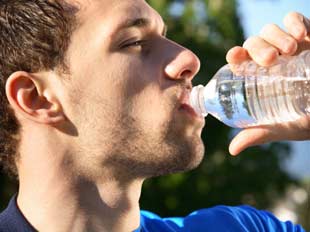Walking on Water
 Sure you remember to drink when thirst reminds you, but a parched tongue is a sign that you’re already dehydrating. It doesn’t take running a marathon in 100 degrees to sap your body’s fluid levels. Even a walk in cool temperatures can dry you out — leaving you susceptible to poor performance, fatigue, and lightheadedness.
Sure you remember to drink when thirst reminds you, but a parched tongue is a sign that you’re already dehydrating. It doesn’t take running a marathon in 100 degrees to sap your body’s fluid levels. Even a walk in cool temperatures can dry you out — leaving you susceptible to poor performance, fatigue, and lightheadedness.
Keep your engine lubricated with these hydro tips:
Perspiration matters. Many factors affect fluid loss. The American Medical Athletic Association recommends calculating sweat rate: Weigh yourself before an hour walk, then after; the difference should account for how much sweat you lose in ounces. Your H2O consumption should match. If you gain weight, you may have depleted your body salt with too much water (hyponatremia). You can restore electrolyte balance with a salty snack or a sports drink.
Color cues. A simple rule of thumb when it comes to monitoring your hydration levels is to note your urine color — which should be clear to pale yellow if you’re getting enough fluids. If it’s deep yellow, you’re tapped out.
Fluid drains. Proper hydration depends not only on how much you drink but what you drink. Your primary source should be water, supplemented by fruits, vegetables, and occasional sports drinks. But limit alcohol and caffeinated beverages, which may deplete your fluids.

